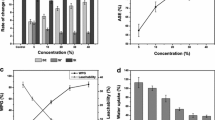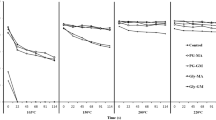Abstract
Glycerol stearate was synthesized by esterification with non-toxic, inexpensive glycerol and stearic acid. The composite of glycerol stearate and Pinus radiata wood was prepared by vacuum impregnation. By Fourier transform infrared (FTIR) analysis, there was the generation of new C=O stretching vibration band of glycerol stearate in comparison with stearic acid. This confirms that glycerol stearate was successfully synthesized. The weight gain, FTIR spectrum and morphological analyses of the composite indicate that glycerol stearate was impregnated into the interior lumina of the cells. Thermal analysis showed that the maximal degradation temperature of the composite was 42 °C higher than untreated wood. Contact angle images indicated that the value of the composite was 134.2°. Hydrophobicity (the repulsion of water) of the composite was stronger than glycerol stearate, which a large number of hydroxyl of wood reacted with the oxygen-containing groups of glycerol stearate, improved hydrophobicity and thermal stability, thereby enhancing the potential application of P. radiata wood.






Similar content being viewed by others
References
Chen H, Miao X, Feng Z, Pu J (2014) In situ polymerization of phenolic methylolurea in cell walls and induction of pulse–pressure impregnation on green wood. Ind Eng Chem Res 53:9721–9727
Deka M, Saikia CN (2000) Chemical modification of wood with thermosetting resin: effect on dimensional stability and strength property. Bioresour Technol 73:179–181
Esteves B, Nunes L, Domingos I, Pereira H (2014) Improvement of termite resistance, dimensional stability and mechanical properties of pine wood by paraffin impregnation. Eur J Wood Wood Prod 72:609–615
Friedrich K, Akpan EI, Wetzel B (2017) Structure and mechanical/abrasive wear behavior of a purely natural composite: black-fiber palm wood. J Mater Sci 52:10217–10229
Gan WT, Xiao SL, Gao LK, Gao RN, Li J, Zhan XX (2017) Luminescent and transparent wood composites fabricated by poly(methyl methacrylate) and γ-Fe2O3@YVO4:Eu3+ nanoparticle impregnation. ACS Sustain Chem Eng 5:3855–3862
Gao ZX, Ma ML, Zhai XL, Zhang M, Zang DL, Wang CY (2015) Improvement of chemical stability and durability of superhydrophobic wood surface via a film of TiO2 coated CaCO3 micro-/nano-composite particles. Rsc Adv 5:63978–63984
Gilani MS, Tingaut P, Heeb M (2014) Influence of moisture on the vibro-mechanical properties of bio-engineered wood. J Mater Sci 49:7679–7687
Giudice CA, Alfieri PV, Canosa G (2013) Siloxanes synthesized “in situ” by sol–gel process for fire control in wood of Araucaria angustifolia. Fire Saf J 61:348–354
Grace LJ, Charity JA, Gresham B, Kay N, Walter C (2005) Insect-resistant transgenic Pinus radiata. Plant Cell Rep 24:103–111
Guo LBB, Cowie AL, Montagu KD, Gifford RM (2008) Carbon and nitrogen stocks in a native pasture and an adjacent 16-year-old Pinus radiata D. Don. plantation in Australia. Agr Ecosyst Environ 124:205–218
Guo B, Liu Y, Zhang Q, Wang F, Wang Q, Liu Y, Li J, Yu H (2017) Efficient flame-retardant and smoke-suppression properties of Mg–Al-layered double-hydroxide nanostructures on wood substrate. ACS Appl Mater Interfaces 9:23039–23047
Ke J, Singh D, Yang XW, Chen SL (2011) Thermal characterization of softwood lignin modification by termite Coptotermes formosanus (Shiraki). Biomass Bioenerg 35:3617–3626
Lang Q, Bi Z, Pu JW (2015) Poplar wood–methylol urea composites prepared by in situ polymerization. II. Characterization of the mechanism of wood modification by methylol urea. J Appl Polym Sci 132:280–288
Lei H, Du G, Pizzi A, Celzard A (2008) Influence of nanoclay on urea-formaldehyde resins for wood adhesives and its model. J Appl Polym Sci 109:2442–2451
Li GY, Hse CY, Qin TF (2015) Wood liquefaction with phenol by microwave heating and FTIR evaluation. J For Res 26:1043–1048
Noël M, Mougel E, Fredon E, Masson D, Masson E (2009) Lactic acid/wood-based composite material. Part 1: Synthesis and characterization. Bioresour Technol 100:4711–4716
Rowell R (1984) The chemistry of solid wood. Wood Sci Technol 19:17–18
Shen DK, Gu S, Bridgwater AV (2010) The thermal performance of the polysaccharides extracted from hardwood: cellulose and hemicellulose. Carbohyd Polym 82:39–45
Soulounganga P, Marion C, Huber F, Gerardin P (2010) Synthesis of poly(glycerol methacrylate) and its application to dimensional stabilization of wood. J Appl Polym Sci 88(3):743–749
Thiebaud S, Borredon ME, Baziard G, Senocq F (1997) Properties of wood esterified by fatty-acid chlorides. Bioresour Technol 59:103–107
Trey SM, Netrval J, Berglund L, Johansson M (2010) Electron-beam-initiated polymerization of poly(ethylene glycol)-based wood impregnants. ACS Appl Mater Inter 2:3352
Trey S, Jafarzadeh S, Johansson M (2012) In situ polymerization of polyaniline in wood veneers. ACS Appl Mater Inter 4:1760–1769
Wang LA, Neoh KG, Kang ET, Shuter B (2011) Multifunctional polyglycerol-grafted Fe3O4@SiO2 nanoparticles for targeting ovarian cancer cells. Biomaterials 32:2166–2173
Yang H, Yan R, Chen H, Dong HL, Zheng C (2007) Characteristics of hemicellulose, cellulose and lignin pyrolysis. Fuel 86:1781–1788
Yin YF, Berglund L, Salmen L (2011) Effect of steam treatment on the properties of wood cell walls. Biomacromolecules 12:194–202
Yuan TQ, Zhang LM, Xu F, Sun RC (2013) Enhanced photostability and thermal stability of wood by benzoylation in an ionic liquid system. Ind Crop Prod 45:36–43
Zhang M, Xu Y, Wang SL, Shi JY, Liu CY (2013) Improvement of wood properties by composite of diatomite and “phenol-melamine-formaldehyde” co-condensed resin. J For Res 24:741–746
Zheng AQ, Jiang LQ, Zhao ZL, Chang S, Huang Z, Zhao K, He F, Li HB (2016) Effect of hydrothermal treatment on chemical structure and pyrolysis behavior of eucalyptus wood. Energy Fuel 30:3057–3065
Author information
Authors and Affiliations
Corresponding author
Additional information
Project funding: This study was funded by the Fundamental Research Funds for the Central Universities (No. 2572017CB24), and the Postdoctoral Scientific Research Starting Foundation of Heilongjiang Province (No. LBH-Q17004).
The online version is available at http://www.springerlink.com.
Corresponding editor: Yu Lei.
Rights and permissions
About this article
Cite this article
Xu, J., Li, B., Zhao, T. et al. Thermal and hydrophobic properties of glycerol stearate-modified Pinus radiata wood. J. For. Res. 30, 1521–1525 (2019). https://doi.org/10.1007/s11676-018-0719-1
Received:
Accepted:
Published:
Issue Date:
DOI: https://doi.org/10.1007/s11676-018-0719-1




